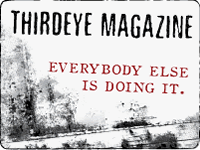Angeldust Apocalypse belongs to an emerging genre called Bizarro fiction, which holds disturbing imagery as one of its defining characteristics. I could focus on these often macabre situations in Angeldust Apocalypse — moments of human body modification, subcutaneous worm trafficking, corporate logo shaped scars — but to do just that would be doing this collection a severe disservice. This collection of 18 short stories does deliver on the promise of its post-modern genre, but doesn’t stop at shock value. Where postmodern fails to offer direction, Jeremy Robert Johnson’s Angeldust Apocalypse builds bright trail markers out of luminescent beetle guts and fetal sinew.
With this book, Johnson’s only story collection, the events aren’t disturbing for the sake of shock, but instead act to inform the characters, drive plot, and ultimately support each story as a crafted experience. In the opener, “A League of Zeroes,” for instance, affection is gained and shared within the culture via body modification, much the way lipstick and eye shadow function in a “traditional” culture. There is an underlying exploration of acceptance as these self-imposed atrocities are encouraged due to the surrounding social context, not merely for the sake of morbid reader accolades. And like great characters should, Johnson’s often translate their position among their particular sub-culture with clarity and poignancy: “We just ended up like this. We followed a natural progression from past to present. We’re not Post-Apocalyptic, we’re Post-Yesterday”
Jeremy Robert Johnson’s Angeldust Apocalypse builds bright trail markers out of luminescent beetle guts and fetal sinew.
The collection isn’t without its stylistic tangents. “Last Thoughts Drifting Down” reads like a prose poem built around the famous Bhagavadgita quote: “I am become death, the destroyer of worlds.” (Later expressed by Manhattan Project scientist Robert Oppenheimer as he watched the first atomic bomb test.) The chaos surfaces in this story and, like its atomic inspiration, is uncontrolled. The closing story, “Wall of Sound: a Movement in Three Parts,” though more reserved, is also afflicted by this experimental approach. These stories could have been left out of the collection without compromising unity, but because the collection is otherwise so strong, I can respect Johnson for including them. He seems to be testing the waters; telling his readers that he is willing to sacrifice a little if it means possibly discovering something deeper.
Other noteworthy stories include: “Snowfall,” a beautiful story of a naïve child embracing nuclear winter on an aesthetic level, unaware of the tragedy the black snow conveys; “The Sharp Dressed Man at the End of the Line,” a prologue to Johnson’s impressive novella follow-up Extinction Journals; and an interesting addition called “Author Notes,” in which Johnson delivers small behind-the-scenes anecdotes on each story.
Think of Angeldust Apocalypse as “Post-Yesterday” magical realism where a dismembered tongue orates the strange while simultaneously maintaining the taste for which it was intended.






No Comments so far ↓
There are no comments yet...Kick things off by filling out the form below.